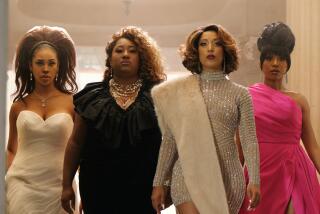Country’s Evolution
- Share via
Ken Burns goes to Nashville?
That, in a nutshell, might be the best description for TBS’ six-hour series “America’s Music: The Roots of Country,” television’s most ambitious look ever at this delightfully colorful genre.
Burns, of course, had nothing to do with this venture--he’s busy working up a new public TV marathon on jazz, the other quintessentially American strain of popular music.
Yet there are similarities between Burns’ expansive documentaries on the Civil War and baseball and the way “The Roots of Country” delves headlong into its rich subject matter.
To a new generation of country-music fans who consider Randy Travis a grizzled veteran, it offers an eye-opening introduction to such towering figures from country’s past as Jimmie Rodgers, the Carter Family, Hank Williams, Bob Wills, Kitty Wells, Lefty Frizzell, Johnny Cash, Merle Haggard, George Jones, Loretta Lynn, Dolly Parton and so many others who paved the way for today’s superstars.
To be sure, scads of the hottest names in contemporary country--from Garth Brooks, Mark Chestnut and Alan Jackson to Wynonna Judd, Mary Chapin Carpenter and the Mavericks--also turn up, either through concert clips, in-studio performances of vintage tunes or on-camera interviews extolling their heroes of yore.
“Our notion from the beginning was to take you back and forth, in and out of history,” said writer Robert K. Oermann, who also wrote the exemplary “Women of Country” special that aired on CBS in 1993. He teamed up for this show with producer Tom Neff, a Nashville-born, USC-educated filmmaker known for his documentaries of visual artists including Red Grooms and Beatrice Wood.
“One reason country lends itself to this kind of treatment is that, unlike other styles of music, all its historical elements are still living, breathing styles today,” Oermann, 48, said by phone from his home in Nashville. “People still play bluegrass, people still sing folk songs, play rockabilly, Cajun, western swing--these are not dead things.”
The series reaches back even before Rodgers and the Carter Family set the tone for modern country in the 1920s. It really began in the 18th and 19th centuries with immigrants--chiefly from the British Isles--who brought with them timeless folk tunes and styles of singing that evolved in their newfound homeland.
Contemporary cowboy singer Don Edwards deftly illustrates that point by crooning a verse of the western classic “Streets of Laredo,” then a verse from “The Old Man’s Lament,” a much older Irish song that’s melodically identical and only slightly different lyrically.
The show also reminds those who may have forgotten, or perhaps never knew, that Elvis Presley was just a humble country singer from Tupelo, Miss., before he became the King of Rock ‘n’ Roll.
Each of the six hours has a different theme. The fifth, for instance, entitled “The Folk Revival,” uses clips of folk kingpin Woody Guthrie and continues into the ‘50s and ‘60s folk movement led by the Weavers, the Kingston Trio, Peter Paul & Mary. That evolved into the folk-rock and country rock of Bob Dylan, Joan Baez, the Byrds and the rest.
In one clip, a twentysomething Dylan warbles a couple of Hank Williams’ songs. Johnny Cash wryly recalls hearing him sing, then writing him a fan letter “on one of those air sickness bags you get in an airplane.” Their ensuing friendship led Cash to invite the folk rocker to Nashville, which in turn helped open the doors of Music City--however gradually--for Dylan’s peers.
Other vintage material, much of which hasn’t been seen in decades, includes 1932 film shorts--music videos a half century before MTV--of Jimmie Rodgers, the great singer, songwriter and yodeler who died in 1933 of tuberculosis at age 35, plus clips of the Carter Family, Bob Wills, Ernest Tubb, Patsy Cline and a slew of others.
“On one hand, we were trying to explain musical styles and the evolutions of an industry,” Oermann said, “and on the other, we were trying to show these folks as people--and they are fascinating people--through sidetrips into costuming, instrument making, fan clubs . . . a visit to a bootmaker, a fiddle festival. . . . We’ve tried to show a whole culture and what it means.”
“The Roots of Country” doesn’t explicitly tackle the de facto “graylist” that is keeping still-active veterans off the radio today and away, for the most part, from major-label record deals, while focusing on young, attractive performers. In one segment, Haggard, one of country’s most revered singers and songwriters, comments: “Today I hear a lot of people singing in tune, a lot of perfect-sounding records, but I don’t hear a lot of emotion.”
For that reason, singer Marty Stuart, also reached by phone in Nashville, said he hopes that “The Roots of Country” will not only entertain viewers, but that it will send a message--to fans, to performers, to country radio and to record companies--about the importance of maintaining a living connection to country’s past.
“If you know where you’ve been,” he said, “you get a better sense of where you’re going. . . . We’ve made a lot of money and gained a lot of ground lately, but how much of that is based on tradition and integrity and how much is based on the cash register?. This show spells out what the heart and soul of country is.”
“America’s Music: The Roots of Country,” Part I, airs Sunday at 4 p.m. (repeats Monday at 7:35 p.m.); Part 2 airs June 9 at 4 p.m. (repeats June 10 at 7:35 p.m.); Part 3 airs June 16 at 4 p.m. (repeats June 17 at 7:35 p.m.). The series airs in its entirety June 29, 9:05 a.m.-3:05 p.m. on TBS.
More to Read
The complete guide to home viewing
Get Screen Gab for everything about the TV shows and streaming movies everyone’s talking about.
You may occasionally receive promotional content from the Los Angeles Times.






